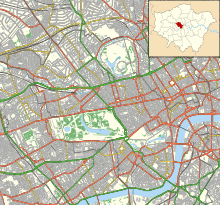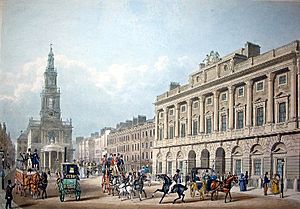Strand, London facts for kids
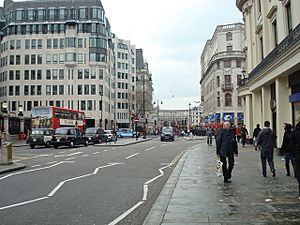
|
|
| Part of | A4 |
|---|---|
| Maintained by | Transport for London |
| Length | 0.8 mi (1.3 km) |
| Postal code | WC2 |
| Nearest Tube station |
|
| Coordinates | 51°30′41″N 0°07′08″W / 51.5114°N 0.1190°W |
Strand is a famous main road in Central London, England. It's located in the City of Westminster. This street is part of London's exciting West End theatre area.
Strand stretches for just over 1.2 kilometers (0.8 miles). It runs from Trafalgar Square in the west to Temple Bar in the east. At Temple Bar, Strand becomes Fleet Street, entering the City of London. It's also part of the A4, a major route heading west from central London.
The name "Strand" comes from an old English word meaning "beach" or "river edge." This is because the street historically ran right next to the north bank of the River Thames. For centuries, grand houses stood along the river side of Strand. These houses were mixed with smaller, crowded alleys.
Important mansions built along Strand included Essex House and Savoy Palace. None of these old buildings survive today. In the 1600s, many wealthy families moved to the West End. Strand then became known for its coffee shops, restaurants, and pubs.
By the 1800s, Strand was a hub for theatre and music hall shows. Several theatres are still there today. At the eastern end of the street, you can see two beautiful churches. These are St Mary le Strand and St Clement Danes. King's College, a part of the University of London, is also located here. Other famous buildings include the Royal Courts of Justice and Australia House.
Many famous writers and thinkers have lived near Strand. These include Charles Dickens and Virginia Woolf. The street is even mentioned in a popular 19th-century song called "Let's All Go Down the Strand".
Contents
Where is Strand?
Strand connects two important parts of London: the City of Westminster and the City of London. It runs east from Trafalgar Square, staying close to the River Thames. It ends at Temple Bar, which marks the border between the two cities. After Temple Bar, the road continues as Fleet Street.
Eastbound traffic on Strand goes around a short curve called Aldwych. This curve connects back to Strand at both ends. The road also forms the southern edge of the Covent Garden area. It is part of the Northbank business district.
The Name's Meaning
The name "Strand" was first recorded in 1002 as strondway. Later, it appeared as Stronde in 1185. The word comes from 'strond', an Old English term for the edge of a river. It first referred to the shallow bank of the Thames. The river used to be much wider before the Victoria Embankment was built. Later, the name was used for the road itself.
In the 1200s, the area was sometimes called 'Densemanestret'. This meant "street of the Danes," referring to a community of Danes who lived there.
Getting Around Strand
Two London Underground stations were once called Strand. One was a Piccadilly line station, now known as Aldwych station. It operated from 1907 to 1994. The other was a former Northern line station. Today, it is part of Charing Cross station.
The Waterloo Bridge was originally called 'Strand Bridge' during its construction. It was renamed when it officially opened. Several London bus routes, including 6, 23, 139, and 176, travel along Strand. Many night bus services also use this road.
History of Strand
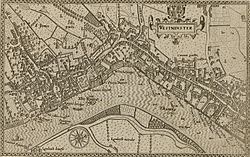
During the time of Roman Britain, Strand was part of a Roman road. This road led to Silchester. Around 600 AD, a trading town called Lundenwic grew in this area. It stretched from Trafalgar Square to Aldwych.
Later, Alfred the Great moved the settlement into the old Roman town of Londinium. This happened around 886 AD. The area of Lundenwic then returned to being open fields.
Medieval Times
In the Middle Ages, Strand became the main route between two separate settlements. These were the City of London, the business center, and the Palace of Westminster, the political center. In the 1200s, King Edward I built Eleanor's Cross at the western end of Strand. This cross honored his wife, Eleanor of Castile. It was taken down in 1647 during the First English Civil War. However, a new one was built in 1865.
Grand Palaces and Houses
From the 1100s, many large mansions lined Strand. These included palaces and townhouses belonging to bishops and royal advisors. Most were on the south side of the street. They had their own gates and docks leading directly to the Thames. The road itself was often in poor condition. In 1532, an order was given to pave it and make it better for travel.
Essex House
What became Essex House was originally an Outer Temple of the Knights Templar in the 1000s. In 1313, it went to the Knights of St John. King Henry VIII gave it to William, Baron Paget in the early 1500s. Robert Dudley rebuilt it in 1563, calling it Leicester House. It was renamed Essex House after Robert Devereux, 2nd Earl of Essex inherited it in 1588. The house was taken down around 1674. Essex Street, which leads to Strand, was built on its site.
Arundel House
Arundel House was originally the London home of the Bishops of Bath and Wells. It was owned by the Earls of Arundel for much of the 1500s and 1600s. After the Great Fire of London in 1666, it became the meeting place for the Royal Society. The house was demolished in 1678. Arundel Street, next to Strand, was built where it once stood.
Somerset House
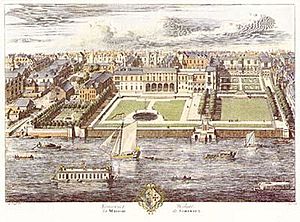
Somerset House was built by Edward Seymour, a powerful regent from 1547 to 1549. He tore down other buildings to make space for it. After Seymour was executed in 1552, it became a home for Princess Elizabeth. When she became Queen in 1558, she gave part of the house back to Seymour's family.
After Elizabeth's death in 1603, Anne of Denmark, wife of James VI and I, owned it. The building was renamed Denmark House. After James died in 1625, his body lay there for a month. Parliament took over the building in 1645, renaming it Somerset House again. It was demolished in 1775 and rebuilt as government offices. Today, it houses art galleries like the Courtauld Institute of Art.
Savoy Palace
Savoy Palace was the London home of John of Gaunt. In the 1300s, it was the most magnificent mansion in England. During the Peasants' Revolt of 1381, rebels destroyed the Savoy. In 1512, it was rebuilt as the Savoy Hospital for the poor. It was later demolished in the 1800s to build the approach road to Waterloo Bridge. The Savoy Hotel now stands on this site.
Durham House
Durham House was the London home of the Bishop of Durham. It was built around 1345. It was also the home of Anne Boleyn. The house was torn down in 1660. Durham Street and the Adelphi Buildings were built where it used to be.
York House
York House was built as the London home for the Bishop of Norwich by 1237. King Henry VIII later acquired it. It became known as York House when he gave it to the Archbishop of York in 1556. In the 1620s, George Villiers, 1st Duke of Buckingham, owned it. It was sold to developers in 1672 and then demolished. New streets like George Street and Villiers Street were built on the site.
Cecil House
Cecil House, also called Exeter House, was built in the 1500s by Lord Burghley. Exeter House was demolished in 1676. Exeter Exchange was built on its site. In 1773, a menagerie (a place for wild animals) was added to the upper floors. It housed lions, tigers, and monkeys. In 1826, a large elephant named Chunee had to be put down. The exchange was demolished in 1829. The site is now home to the Strand Palace Hotel.
Other Important Houses
Other important palaces along Strand included Worcester House and Salisbury House. Bedford House was demolished in 1704. Hungerford House was replaced by Hungerford Market and later Charing Cross station. Northumberland House, a large mansion built in 1605, was demolished in 1874. Northumberland Avenue now stands there.
Almost all these grand buildings were demolished from the 1600s onwards. A New Exchange, a high-class shopping center, was built in 1608-1609. It was very popular but was destroyed in 1737.
Strand in Modern Times
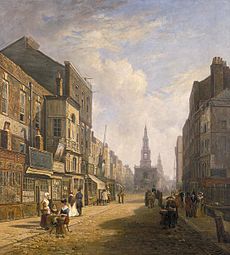
In the 1600s, many grand mansions on Strand were torn down. Wealthy families moved to the West End. The Duck and Drake tavern on Strand was known as a meeting place for the plotters of the Gunpowder Plot.
In the 1700s, coffee and chop houses opened on the street. Twinings tea shop started at No. 206 in 1706. It was founded by Thomas Twining, who supplied tea to Queen Anne. The company claims to be the oldest business paying taxes in Westminster. The alleyways around Strand were known for pickpockets during this time.
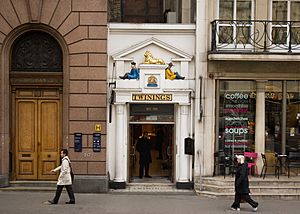
Simpson's-in-the-Strand started in 1828 as a smoking and dining club. It later became a famous restaurant. Strand was also a center for the British book trade in the 1700s. Many printers and publishers had shops there.
In the 1800s, much of Strand was rebuilt. The houses on the south side no longer faced the Thames directly. The Victoria Embankment was built between 1865 and 1870. This project reclaimed 37 acres (15 hectares) of land, separating the street from the river.
King's College, London was founded in 1828. Its historic King's Building was designed by Robert Smirke. It was built from 1829 to 1831. The Royal Courts of Justice, at the eastern end of Strand, were designed in the 1860s. They replaced older courts at Westminster Hall. Queen Victoria opened the courts in 1882.
The architect John Nash redeveloped the western end of Strand in the 1830s. This included building Charing Cross Hospital.
Strand became famous for its many theatres. At one point, it had more theatres than any other street. These included the Adelphi, Gaiety, Savoy, and Vaudeville. Today, only the Adelphi, Vaudeville, and Savoy remain.
Charing Cross railway station was built on Strand in 1864. It offered train services to Europe. This led to more hotels being built in the area for travelers. These included the Charing Cross Hotel, connected to the station. Today, Strand has luggage shops, travel agents, and stamp dealers. The stamp collector Stanley Gibbons opened a shop here in 1891.
The Strand Palace Hotel was built between 1925 and 1930. Its original entrance was moved to the Victoria and Albert Museum in 1968. Strand saw a lot of rebuilding in the mid-1900s. The road from St Mary's east to St Clement's was widened in 1900. This made the two churches, St Mary Le Strand and St Clement Danes, stand as islands in the middle of the road.
In 1998, a statue of Oscar Wilde was placed near the western end of Strand. Between 2021 and 2022, Westminster City Council worked on the Strand Aldwych Scheme. This made part of Strand a pedestrian-only area. Aldwych was changed to a two-way street.
Churches on Strand
The church of St Clement Danes is thought to date back to the 800s. Its name might come from Harold Harefoot, a Danish king buried there. Or it could be from a place where Danes found safety after Alfred the Great's conquest. Henry II gave it to the Knights Templar in 1189. It survived the Great Fire of London in 1666. However, it was rebuilt by Christopher Wren in 1679.
The church was damaged during the Blitz in 1941. Much of its inside was destroyed. It was rebuilt in 1958 and now serves as the central church of the Royal Air Force. This church is one of two possible places mentioned in the nursery rhyme "Oranges and Lemons".
St Mary le Strand was designed by James Gibbs and finished in 1717. It replaced an earlier church that was torn down for Somerset House. It was the first building designed by Gibbs. The column on top was meant for a statue of Queen Anne. But after her death in 1714, a spire was added instead. It survived the Blitz but was in poor condition. John Betjeman led a campaign to restore it in the 1970s.
Essex Street Chapel, where British Unitarianism began, is also near Strand. The original chapel was built in 1774. It was damaged in the Blitz but restored after the war. It now serves as the main office for the General Assembly of Unitarian and Free Christian Churches.
Famous People Who Lived Here
The print seller Rudolph Ackermann lived and worked at No. 101 The Strand from 1797 to 1827. His shop was one of the first to have gas lighting.
In the 1800s, Strand became a fashionable place to live. Many new writers and thinkers gathered here. These included Thomas Carlyle, Charles Dickens, John Stuart Mill, and Ralph Waldo Emerson. No. 142 was the home of publisher John Chapman. He published many writers from this house in the 1850s. George Eliot lived at No. 142 between 1851 and 1855. Virginia Woolf often traveled along Strand. A King's College building in nearby Kingsway is named after her.
Images for kids
See also
 In Spanish: Strand (Londres) para niños
In Spanish: Strand (Londres) para niños
- Australia House
- Gibraltar House
- Lancaster Place
- Savoy Court
- Southampton Street
- Strand School
- Zimbabwe House


